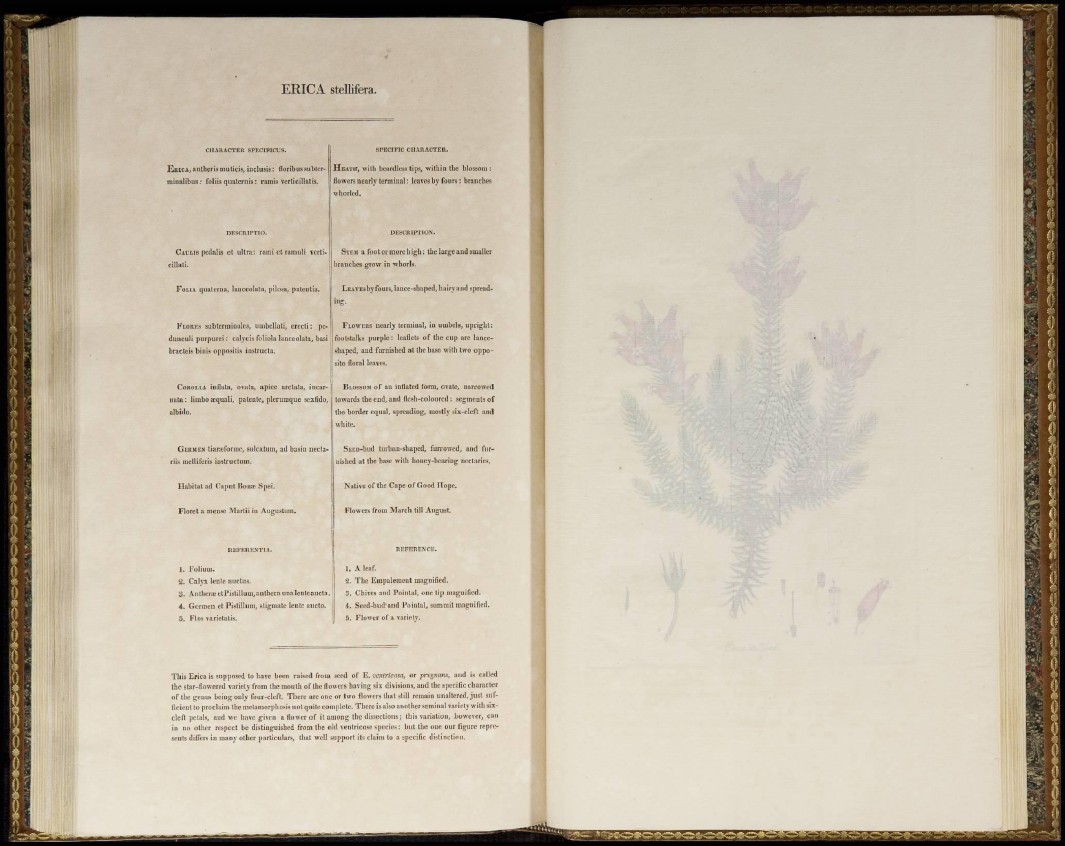
ERICA steUifera.
CHARACTER SPECIFICU5,
ERICA, antheris muticis, incluais : floribus subtcrrainalibus;
foliis quaternis : ramis verticillatis.
D E S C R 1 P T 1 0 .
CAULIS pedalis et ultra: rami ct ramuli vcrticillati.
FOLIA quaterna, lauceolata, pilosa, patentia.
FLORES sub Ierro in ales, umbcllati, erecti: pcdunculi
purpurei : calycis folióla lauceolata, basi
bracteis binis oppositis instructa.
COROLLA inflata, ovala, ápice arctata, incarnata:
limbo oequali, patente, plerumque sexfido,
albido.
GERMEN tiarasformc, sulcatum) ad basin nectariis
melliferis inslructum.
Habitat ad Caput Bona; Spei.
Floret a mcnse Martii in Augustiim,
REPERENT IA.
1. Folium.
2. Calyx leute auctus.
3 . Antbera:etPistilIuni,autberaunalenteaucta.
4. Germen et Pistilluni, stigmate lente aucto.
5. Flos varictatis.
SPECIFIC CHARACTER.
HEATH, with beardless tips, within the blossom :
flowers nearly terminal: leaves by fours: branches
whorlcd.
DESCRIPTION.
STEM a foot or more high: the large and smaller
branches grow in whorls.
LEAVES by fours, lance-sbaped, hairy and spreading.
FLOWERS nearly terminal, in umbels, upright:
footstalks purple: leaflets of the cup arc lanceshaped,
and furnished at the base with two opposite
floral leaves.
BLOSSOM of an inflated form, ovate, narrowed
towards the end, and flesh-coloured : segments of
the border equal, spreading, mostly six-cleft and
white.
SEED-bud turban-shaped, furrowed, and furnished
at the base with honey-bearing nectaries.
Native of the Cape of Good Hope.
Flowers from March till August.
REFERENCE.
1. A leaf.
2. The Empnlemcnt magnified.
3 . Chives and Poinlal, one tip magnified.
4. Seed-bud'and Pointal, summit magnified.
5. Flower of a variety.
This Erica is supposed to have been raised from seed of E. ventricosa, or pregnrtns, and is called
the star-flowered variety from the mouth of the flowers having six divisions, and the specific character
of the genus being only four-cleft. There are one or two flowers that still remain unaltered, just sufficient
to proclaim the metamorphosis not quite complete. There is also another seminal variety with sixcleft
petals, and we have given a flower of it among the dissections; this variation, however, can
in no other respect be distinguished from the old ventricose species: but the one our figure represents
differs in many other particulars, that well support its claim to a specific distinction.